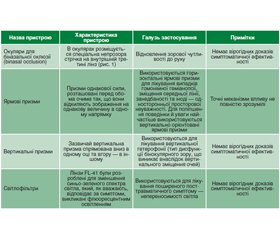Архив офтальмологии Украины Том 11, №1, 2023
Вернуться к номеру
Аналіз cучасних технологій діагностики й лікування бінокулярного зору і слабкозорості, набутих унаслідок травматичних уражень ока й головного мозку
Авторы: Петров В.В. (1), Риков С.О. (2), Крючин А.А. (1), Антонов Є.Є. (1), Шаргородська І.В. (2), Шанойло С.М. (1), Бутенко Л.В. (1)
(1) — Інститут проблем реєстрації інформації НАН України, м. Київ, Україна
(2) — Національний університет охорони здоров’я України імені П.Л. Шупика, м. Київ, Україна
Рубрики: Офтальмология
Разделы: Справочник специалиста
Версия для печати
Проведено аналіз базових технологій використання мікропризмових структур для лікування порушень зору, набутих унаслідок травмування ока й головного мозку. Визначені переваги неінвазивного лікування таких порушень зору. Наведено результати використання мікропризмових структур для лікування порушень зору. Показано, що застосування мікропризмових структур дозволяє в багатьох випадках здійснювати ефективне лікування порушень зору, набутих унаслідок травмування ока й головного мозку. Аналіз результатів використання мікропризмових структур для неінвазивного лікування таких порушень зору показує, що висока якість лікування може бути досягнута при використанні мікропризмових структур високої оптичної якості. Досвід використання спеціально розроблених жорстких призм Френеля показує, що вони є ефективним методом лікування бінокулярного зору.
An analysis of the basic technologies of using microprism structures for the treatment of visual impairments acquired as a result of eye and brain injuries has been carried out. The advantages of non-invasive treatment for such vision disorders have been determined. The results of using microprism structures for the treatment of vision disorders are given. It is shown that the use of microprism structures in many cases allows to effectively treat visual impairments acquired due to eye and brain injuries. Analysis of the results of non-invasive treatment for such vision disorders shows that its high quality can be achieved when using microprism structures of high optical quality. Experience of using specially designed rigid Fresnel prisms shows that they are an effective method of treating binocular vision.
мікропризмові структури; неінвазивне лікування порушень зору; черепно-мозкові травми; лікування бінокулярного зору
microprism structures; non-invasive treatment of vision disorders; craniocerebral injuries; treatment of binocular vision
Для ознакомления с полным содержанием статьи необходимо оформить подписку на журнал.
- Merezhinskaya N., Mallia R.K., Park D., Bryden D.W., Mathur K.B.S., Barker F. Visual Deficits and Dysfunctions Associated with Traumatic Brain Injury: A Systematic Review and Meta-analysis. Optometry and Vision Science. 2019. 96(8). P. 542-555. doi: 10.1097/OPX.0000000000001407.
- Russel L. Post Trauma Vision Syndrome. April 12, 2020. https://www.optometrists.org/vision-therapy/neuro-optometry/vision-and-brain-injuries/traumatic-brain-injury-and-neuro-optometry/vision-problems-and-traumatic-brain-injury.
- https://www.neurovisionaustin.com/2019/08/05/micro-prism-lenses-may-be-the-answer.
- Langlois J.A., Rutland-Brown W., Wald M.W. The epidemio–logy and impact of traumatic brain injury. J. Head Trauma Rehabil. 2006. 21(5). P. 375-378. doi: 10.1097/00001199-200609000-00001.
- Hussain S.F., Raza Z., Cash A.T.G., Zampieri T., Mazzoli R.A., Kardon R.H., Gomes R.S.M. Traumatic brain injury and sight loss in military and veteran populations — a review. Mil. Med. Res. 2021. 8(1). P. 42. doi: 10.1186/s40779-021-00334-3.
- Vision Problems After Traumatic or Acquired Brain Injury. https://www.visiontherapysuccess.com/headtrauma.php.
- Subramanian P.S., Birdsong R.H. Surgical management of traumatic strabismus after combat-related injury. Mil. Med. 2008 Jul. 173(7). 693-6. doi: 10.7205/milmed.173.7.693. PMID: 18700606.
- Петров В.В., Антонов Е.Е., Крючин А.А., Шанойло С.М. Микропризмы в офтальмологии К.: Наук. думка, 2019. 224 с.
- Woo G.C., Lovasik J.V. Fresnel prism correction for trauma-induced diplopia. Ophthalmic Physiol. Opt. 1985. 5(1). P. 59-62. https://doi.org/10.1111/j.1475-1313.1985.tb00636.xPMID: 3975046.
- Véronneau-Troutman S. Fresnel prisms and their effects on visual acuity and binocularity. Trans. Am. Ophthalmol. Soc. 1978. 76. P. 610-653. PMID: 754384; PMCID: PMC1311638.
- Ciuffreda K.J., Kapoor N., Rutner D., Suchoff I.B., Han M.E., Craig S. Occurrence of oculomotor dysfunctions in acquired brain injury: a retrospective analysis. Optometry. 2007. 78(4). 155-61. doi: 10.1016/j.optm.2006.11.011.
- About brain injuries & vision. https://noravisionrehab.org/patients-caregivers/about-brain-injuries-vision.
- Vision Problems After Traumatic or Acquired Brain Injury. https://www.visiontherapysuccess.com/headtrauma.php.
- Armstrong R.A. Visual problems associated with trauma–tic brain injury. Clin. Exp. Optom. 2018 Nov. 101(6). 716-726. doi: 10.1111/cxo.12670. Epub 2018 Feb 28. PMID: 29488253.
- Fox S.M., Koons P., Dang S.H. Vision Rehabilitation After Traumatic Brain Injury. Physical Medicine and Rehabilitation Clinics of North America. 2018. doi: 10.1016/j.pmr.2018.09.001.
- Conrad J.S., Mitchell G.L., Kulp M.T. Vision Therapy for Binocular Dysfunction Post Brain Injury. Optom. Vis. Sci. 2017 Jan. 94(1). Р. 101-107. doi: 10.1097/OPX.0000000000000937. PMID: 27464572.
- Subramanian P.S., Birdsong R.H. Surgical Management of Traumatic Strabismus after Combat-Related Injury. Military Medicine. 2008. 173(7). P. 693-696. https://doi.org/10.7205/MILMED.173.7.693.
- Barton J.J.S., Ranalli P. Vision therapy: occlusion, prisms, filters and vestibular exercises for mild traumatic brain injury. Survey of Ophthalmology. 2020. doi: 10.1016/j.survophthal.2020.08.001.
- Taub M.B., Harris P., Groce А. Make Way For Yoked Prism. https://www.reviewofoptometry.com/article/make-way-for-yoked-prism.
- Bowan M. Microprism Application in Acquired Brain Injury: A significant treatment intervention. 2015. doi: 10.13140/RG.2.1.1997.3602.
- Visual dysfunctions common in even mild TBI patients. https://health.mil/News/Articles/2021/03/30/Visual-dysfunctions-common-in-even-mild-TBI-patients.
- Suzuki T. Treatment at paralytic strabismus and indication of prism spectacles. Japanese Orthoptic Journal. 2018. 47. P. 25-28. doi: 10.4263/jorthoptic.047S002.
- Flanders M., Sarkis N. Fresnel membrane prisms: clinical experience. Can. J. Ophthalmol. 1999 Oct. 34(6). P. 335-40. PMID: 10604055.
- Gunton K.B., Brown A. Prism use in adult diplopia. Current Opinion in Ophthalmology. 2012. 23(5). P. 400-404. doi: 10.1097/icu.0b013e3283567276.
- Doble J., Feinberg D., Rosner M., Rosner A. Identification of Binocular Vision Dysfunction (Vertical Heterophoria) in Traumatic Brain Injury Patients and Effects of Individualized Prismatic Spectacle Lenses in the Treatment of Postconcussive Symptoms: A Retrospective Analysis. PM & R: the Journal of Injury, Function, and Rehabilitation. 2010. 2. P. 244-253. doi: 10.1016/j.pmrj.2010.01.011.
- Fujiwara K., Ukai K., Takai Y., Ito Y., Terasaki H. Usefulness of Trial Fresnel Membrane Prisms before Prism Glasses Prescription to Improve Double Vision in Adults. Japanese Orthoptic Journal. 2015. 44. P. 35-42. doi: 10.4263/jorthoptic.044F002.

